Costa Rica is celebrated as one of the best beach vacation destinations for its gorgeous beaches, lush tropical rainforest and an abundance of fascinating wildlife. In addition to numerous white-sand beaches backed by towering palm trees, Costa Rica is also home to five breathtaking active volcanoes, making this tropical country an ultimate eco tourism destination.
Volcanic eruptions have helped make Costa Rica’s soil highly fertile, which directly benefits the growth of dense tropical rainforests. Contributing to Costa Rica’s rich biodiversity, this combination of fertile soil and dense rainforest provides the perfect habitat for some of the most beautiful creatures in the world.
Perhaps one of the greatest things about Costa Rica is its size; there are not many vacation destinations that you can visit in the world where you can travel from pristine beaches to mesmerizing volcanoes and onto a cloud forest in a matter of hours. If you’re planning a family vacation or destination wedding in Costa Rica, make sure to include a trip to one of the Costa Rica’s fascinating volcanoes. From the exploding, glowing lava flow of the Arenal Volcano to the huge smouldering giant that is the Poas Volcano, these are active natural wonders of the world are some of the best Costa Rica attractions worth visiting while on vacation in paradise.
Information About Costa Rica Volcanoes
Forming part of the Pacific ring fire circle, the majority of Costa Rica’s volcanoes can be found in the northern part of the country as well as the Central highlands.
The volcanoes of Costa Rica are divided into 3 volcanic range systems:
- The Guanacaste Volcanic Range is home to the Rincon de la Vieja Volcano, Orosi Volcano, Miravalles Volcano, Tenorio Volcano and Arenal Volcano
- The Central Volcanic Range is the location of Poas Volcano, Barva Volcano, Irazu Volcano and Turrialba Volcano
- The Talamanca Volcanic Range is home to one volcano, El Viejo Volcano
- Of all these volcanoes in Costa Rica; Arenal Volcano, Poas Volcano, Ricon de la Vieja Volcano, Orosi Volcano & Irazu Volcano are considered active
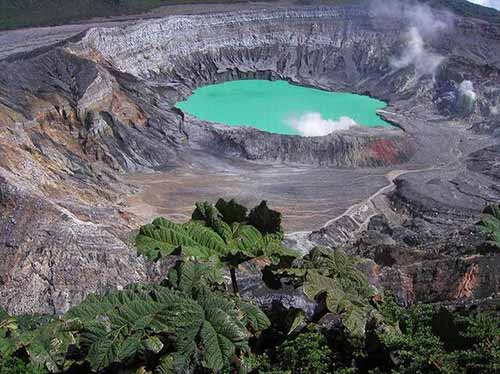
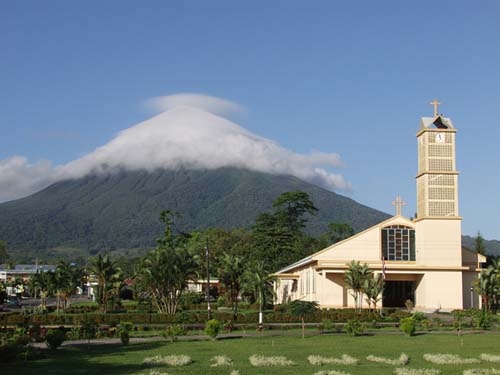
The Best Volcanoes to Visit in Costa Rica
Arenal Volcano
For a spectacular firework display of molten lava, head to the famed Arenal Volcano, located in the Guanacaste Volcanic Range. Due to its activity, most spectacular upon nightfall, Arenal Volcano is the most famous of all of Costa Rica’s volcanoes. Thought to have a perfect volcanic cone, Arenal Volcano is indeed a sight to behold as it sits towering amidst the surrounding landscape of Arenal National Park.
Facts About Arenal Volcano
- Arenal Volcano is located in the province of Alajuela, canton of San Carlos, and the district of La Fortuna Costa Rica
- One of the ten most active volcanoes in the world, Arenal Volcano measures a minimum of 1,633 meters (5,366 ft.)
- In geological terms, Arenal Volcano is considered a young volcano with an estimated age of less than 3,000 years
- Due to the high level of activity, Arenal Volcano grows on average six meters (20 ft.) each year
- Arenal Volcano has been continually active since 1984. The last recorded eruption of Arenal Volcano was on May 5th – 7th, 1998, where sections of the northwest wall of the remaining crater fell apart. Lava began to flow from the crater in larger amounts than previously recorded and the local authorities took the necessary steps to secure the area
- Residents of La Fortuna Costa Rica and the surrounding areas of Arenal are familiar with the evacuation procedure and local seismologists constantly monitor the volcano’s activity
- Arenal Volcano is also known as Pan de Azúcar, Canaste, Volcan Costa Rica, Volcan Río Frío or Guatusos Peak.
- Arenal Volcano is one of the most popular eco tourism destinations in Costa Rica, with up to 800,000 visitors to the Arenal National Park every year
- Due to the high activity of Arenal Volcano, La Fortuna boasts of natural hot springs, nestled within the volcanic rocks and lush tropical greenery that define this beautiful area of Costa Rica.
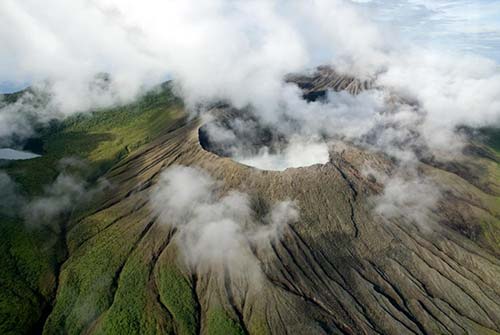
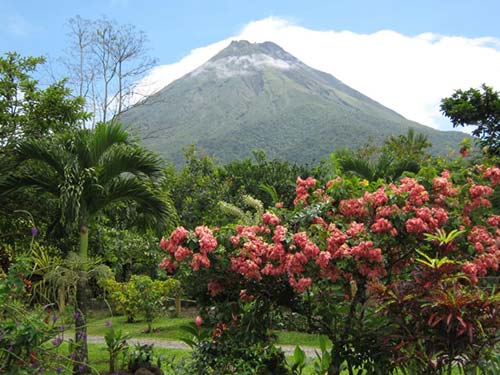
Tours and Activities in La Fortuna
Lake Arenal
Arenal Volcano and Lake Arenal are located within the boundaries of Arenal National Park. Recognizing the importance of ecological energy production, Lake Arenal functions as a reservoir which provides the main source of power for the country’s hydroelectricity program.
- Due to consistent wind conditions, Lake Arenal is a popular extreme water sports and eco tourism location, considered amongst the best in the world. Visitors can enjoy:
- Windsurfing, kite surfing and charter fishing tours are available in Lake Arenal
- Hiking tours, mountain bike rides, canopy tours, sky tram aerial tours, white water rafting, horseback riding tours, boating safari tours and ATV tours
Relax at Arenal Volcano Hot Springs
Natural hot springs are abundant and in proximity of Arenal Volcano because its magma is close to the earth’s surface. The magma heats the water from the natural hot springs which is then brought to the surface. Hot springs are recognized for their medicinal properties due to the minerals that the water contains. Added benefits of hot springs include stress relief which can directly affect different medical conditions.
La Fortuna Waterfall
Not far from the village of La Fortuna sits the picture perfect La Fortuna waterfall, which can be visited via a hiking tour or horseback tour. La Fortuna waterfall is an impressive and powerful 70 meters high. With a breathtaking backdrop of tropical greenery and an abundance of fascinating wildlife, the waterfall at La Fortuna is a truly amazing Costa Rica eco tour.
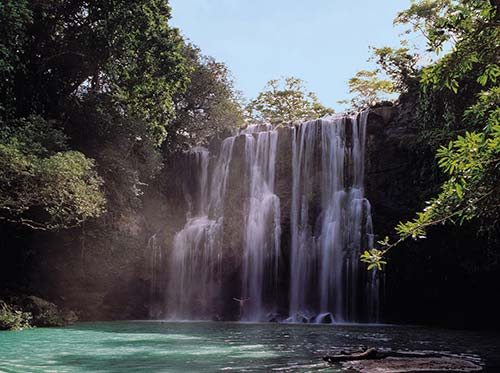
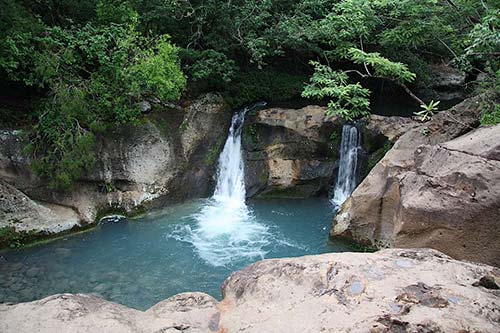
Poas Volcano
If you visiting San Jose for a while before you venture out to your beach vacation destination in Costa Rica, then schedule a tour to the stunning Poas Volcano National Park. Poas Volcano is considered to be one of the most accessible active volcanoes in Costa Rica, located only 29 miles (47 kilometers) from San Jose and situated in the province of Alajuela, a pleasant 1.5 hour drive. Going past vast coffee and flower plantations and up into the mountains, there are plenty of photo opportunities before arriving at Poas Volcano; the panoramic views are simply amazing.
Positioned within the Poas Volcano National Park, a visit to this Costa Rica volcano is an enjoyable day out for all of the family. A highly recommended eco adventure for all the family, enjoy bird watching and hiking within Poas Volcano National Park.
High on the list of Costa Rican attractions, Poas Volcano has one active crater. Celebrated for its bubbling turquoise blue lake, you can view the active crater of Poas Volcano from several staggered view points within the national park.
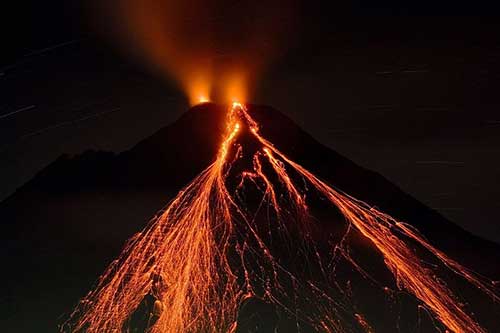
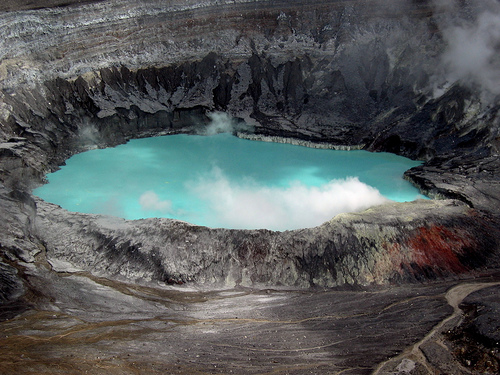
Facts about Poas Volcano
- There have been 39 Poas Volcano eruptions, the first recorded in 1828
- Poas Volcano has one active and two dormant craters and belongs to the Central Volcanic Range
- The active crater known as laguna caliente, (hot lagoon) is located in the north. It is 1.5 km wide and 985ft deep. The bottom of this lagoon is covered in a layer of liquid sulphur and is surrounded by vegetation and active steaming geysers
- Poas Volcano geyser explosions can reach up to 820ft, (250 meters)
- Lake Botos is in the south and is an inactive crater surrounded by the cloud forest that defines the landscape of the Poas Volcano National Park.
- The highest point of elevation of Poas Volcano reaches 8,885 ft (2,708 meters) above sea level. The main crater rim is 160 feet (50 meters) lower
- Poas Volcano National Park has an extension of 13,838 acres or 5,600 hectares.
Poas Volcano Tours and Activities
- Poas Volcano National Park is open from 8 a.m. to 4 p.m. Try to get to the volcano early as the clouds do begin to cover the volcano after midday
- Be prepared for a few short walks; wear comfortable footwear
- The first level trail starts at the visitor’s center and takes you through the dense national park vegetation that surrounds the Poas Volcano. The pleasant walk takes about fifteen minutes; distance to main crater from visitors center: 0.3 miles, (0.5 km)
- Once you have reached the first viewing platforms at the main crater you can then take a slightly longer and steeper trail to Botos Lake; distance from main crater to Botos Lake: 0.9miles, (1.4 km)
- If you are an avid birdwatcher then take the Escalonia Cloud Forest trail; an excellent opportunity to see bird species that live in Poas Volcano National Park. Extension of trail: 0.6 miles (1 km)
- Poas Volcano National Park Visitors Centre offers a small exhibition about volcanism including information on erupting volcanoes and active volcanoes around the world. There are also displays detailing the Costa Rican wildlife that can be found in the area. There is also a cafeteria, Café Botos serving snacks and refreshments, toilets with access for people with disability and a souvenir shop
Directions to Poas Volcano National Park
From San Jose, take the Pan American Highway west to Alajuela, across the highway from the airport, which enters into town on Calle 2.
Follow Calle 2 all the way through town until it becomes route 130 to Itiquis and Fraijanes. There will be signs for Poas Volcano National Park. If you are uncertain, stop for directions before leaving Alajuela. Once you are on the right road out of town it takes you directly to Poas Volcano.
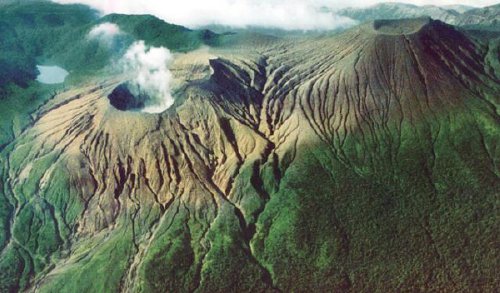
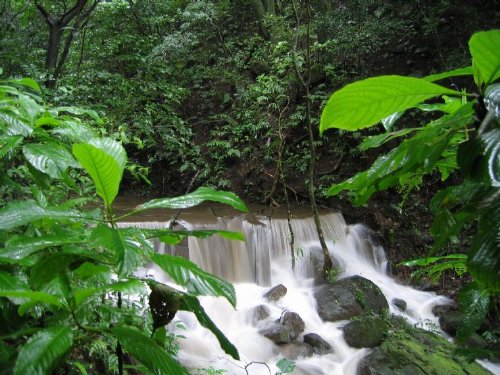
Rincon De La Vieja Volcano
Located in the province of Guanacaste, Rincon de la Vieja Volcano is surrounded by nine adjoining craters that lie within the Rincon de la Vieja National Park. With a total of 34,800 acres, the national park offers an exciting eco adventure trip for a wonderful family vacation in Costa Rica. Its vast extension includes dense tropical forests home to an abundance of Costa Rica’s most fascinating wildlife including sloths, pumas, howler monkeys, tapirs, skunks, armadillos and many species of birds including the white fronted parrot, the spectacled owl, the laughing falcon and the emerald toucanet.
Rincon de la Vieja Volcano is the most active of the five volcanoes positioned within the Guanacaste range and is located 25 kilometers from Liberia, close to some of Costa Rica’s best beach vacation destinations including Playa Tamarindo, Playa Flamingo and the Gulf of Papagayo. If you enjoy hiking, bird watching and outdoor adventure then pay a visit to Rincon de La Vieja National Park; you won’t be disappointed! If you are a particularly adept hiker and love extreme sports then this is one of the few volcanoes in the world where you can visit the summit.
Facts about Rincon de la Vieja Volcano
- Rincon de la Vieja is located at an altitude of 6217 ft, (1895 meters)
- Its name means “The Old Woman’s Corner.” Local legend attributes the name of the volcano to the tale of an Indian princess who fell in love with a man from a tribe different to that of her own. When her family found out, the man was thrown into the mouth of the volcano; the grieving princess left her tribe and spent the rest of her days roaming the volcano mourning the loss of her loved one
- Rincon de la Viejav Volcano is made up of nine adjacent craters located within the national park
- With intermittent volcanic eruptions and a turquoise blue acidic lake, the Von Seebach crater is the most active and is the main crater of Rincon de La Vieja Volcano
- The Rincon de la Vieja Volcano erupted most recently in February 1998
- Of the nine craters, the Santa Maria Volcano is the highest at 6,385 ft (1916 m)
- Large number of hot pools and areas of bubbling mud are found in two areas on the slopes of the volcano, indicating substantial reserves of geothermal energy
Rincon de la Vieja Volcano Tours and Activities
- If you enjoy hiking, wildlife, bird watching and geology tours then Rincon de la Vieja Volcano National Park is the perfect location to enjoy all of these activities. Hiring an experienced local guide will ensure that you get an in-depth tour of the national park
- If you are looking for an eco adventure tour in Costa Rica like no other then climb to the summit of the Rincon de la Vieja Volcano. It’s a challenging all day, 8 kilometer uphill hike starting off in Las Pailas Ranger Station. With a gentle upward slope the first 6 kilometers are hard going but the last 2 kilometers are the most challenging with steep ascent to the main crater. Covering a total of 5,000 vertical feet make sure you bring enough water for this hike through the Rincon de la Vieja Volcano National Park. Your reward when you reach the summit? Enjoy the incredible panoramic views of the majority of Costa Rica including both the Pacific and Atlantic coasts!
- Visit Rincon de la Vieja National Park during the green season which runs from May through to November. The fumaroles and mud pots are at their most active during this time of the year and you will find that the summit is clouded over for most of the other months
- There are canopy tours, horseback riding, river rafting and ATV tours in the available in the immediate area of Rincon de La Vieja National Park
- Other hiking trails begin at the Santa Maria ranger station and lead into others areas of the park where you will be able to see hot mud pots and relax in the naturally heated pools or take a dip in the cooler waters of passing streams. Other trails lead to picturesque waterfalls and refreshing swimming holes
- Camping is permitted within the Rincon de la Vieja National Park grounds but there are no installations to purchase food so make sure you bring a generous supply if you plan to stay here for any length of time
Directions to Rincon de la Vieja Volcano
From Liberia, take the Pan American highway #1 north. You will see signs for Rincon de la Vieja National Park after approximately 5 kilometers of driving on the Pan American highway. Turn right on a gravel road and follow the road to the town of Curubande.
Continue this road and you will find the signs for two of the lodges in the area; Rincon de la Vieja Lodge and Hacienda Guachipelin. On the road you will find a closed gate. Please honk and someone will come out and charge you USD $2 per car for the use of this private road. This road leads to Rincon de la Vieja Volcano.
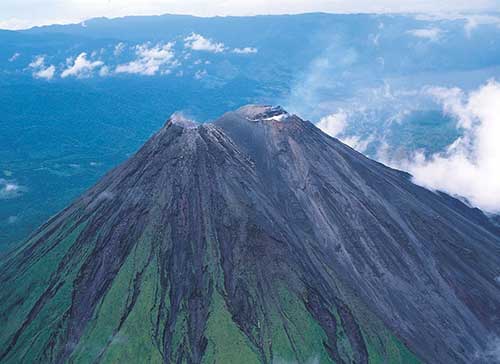
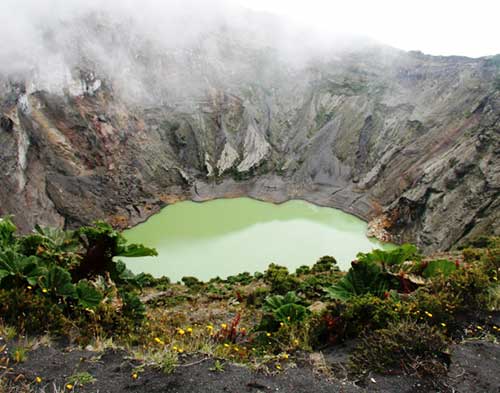
Irazu Volcano
Irazu Volcano is located close to the city of Cartago; it is the tallest and most active volcano in Costa Rica. If you are staying in the country’s capital city of San Jose, then this is a great day trip out away from the concrete jungle. Once you pass through Costa Rica’s old capital city of Cartago, a 24 mile (39 kilometer) trip will take you up from the Central Valley and through vast extensions of potato, onion and cabbage fields as well as dairy farms.
Irazu Volcano is notable for its explosive eruptions, the last of which was in 1960’s. Many Costa Ricans have vivid memories of the four years in which Cartago and San Jose were continually covered with volcanic ash and smoke as Irazu Volcano continually erupted.
Situated within the Irazu Volcano National Park, Irazu Volcano landscape is barren, looking much like the surface of the moon. Several deep craters are lined with singed vegetation and mineral pools.
Facts about Irazu Volcano
- Located with the Central Volcanic range, Irazu Volcano is the tallest in the country with a height of 11,260 ft, (3,432m)
- Although it is not clear how Irazu Volcano got its name, researchers believe that it comes from an indigenous dialect that combined “ara” (point) and “tzu” (thunder)
- In Costa Rica it is known by the name of “El Coloso” (The Colossus) due to the catastrophes that it has provoked in the past
- The largest of these craters is 900 ft (275 m) deep
- The smallest crater of Irazu Volcano is named Diego de la Haya, dips some 300 ft (91 m) beneath the surface
- Its mineral-rich lake changes in color, changing from acid turquoise to deep metal red
- On a cloudless day the Pacific and Caribbean coasts are visible from the summit
- It is the highest active volcano in Costa Rica
- Irazu Volcano has had a very active past with at least 23 eruptions, the first recorded in 1723
- The most famous eruption began on the day that US President John F. Kennedy visited Costa Rica in 1963. After his return to the United States he ordered am emergency delivery of supplies to the people who were affected by the eruptions
Irazu Volcano Tours and Activities
- There are plenty of hiking trails throughout Irazu Volcano National National Park
- The hiking trails are a total distance of 1 kilometers and run between the main crater and Diego de la Haya, Playa Hermosa and La Laguna craters
- Visit the volcano in the early morning between December and April if you want to get a good view of the crater and the surrounding Costa Rican landscape
- Due to the volcanoes elevation make sure you bring a sweater, it gets gold at the summit and make sure you take sun block with too
- Irazu Volcano National Park has a small visitor’s center with informative displays and a small museum about active and erupting volcanoes around the world
- The visitor center and viewpoint at Irazu Volcano also has a small coffee shop and tables; open from 8:00am to 4:00pm
- The guard station is manned from 8:00 a.m. to 3:30 p.m
- To the southwest of Irazu Volcano you will find the Ricardo Jimenez Oreamuno Recreation Area which has additional trails and offers camping. This park zone is the site of a reforestation project to restore the area which was destroyed by the major eruptions of 1963-65
- If you are looking for more activities to fill your day then pay a visit to the Lankester Botanical Gardens just outside Cartago
- You can also schedule a coffee plantation tour; this area of Costa Rica is filled with coffee farms
Directions to Irazu Volcano
From San Jose, take the highway to Cartago about a 14 mile (23 kilometer drive). From Cartago travel a further 24 miles (39 kilometers) on winding road that leads you up through the mountains all the way to the visitor center.
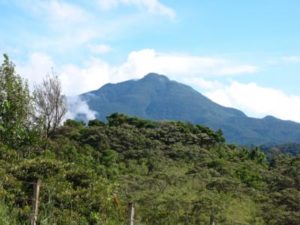
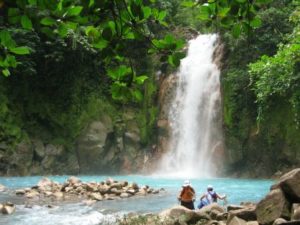
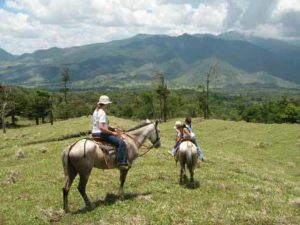
Tenorio Volcano
The Tenorio Volcano and the Miravalles protected area are located in the province of Guanacaste. The volcano forms part of the Arenal Tilaran Conservation Area and belongs to the Guanacaste Volcanic range. The Tenorio Volcano is located 26 miles from La Fortuna near Arenal Volcano. If you are looking for an exciting eco adventure in Costa Rica then visit the Tenorio Volcano for a fun and relaxing day out.
Tenorio Volcano is perhaps best known for its turquoise blue Rio Celeste, a combination of sulfur and calcium carbonates but the immediate surrounding area offers a variety of activities that are sure to keep all the family entertained, such activities include horseback riding and river rafting to visiting the nearby hot springs and Puma refuge.
If you are driving from San Jose you can visit the Tenorio Volcano National Park en-route to the beautiful paradise beaches of Guanacaste. Covered in primary cloud forest the Tenorio Volcano National Park is filled with rivers, waterfalls and hot springs home to an abundance of fascinating Costa Rica wildlife.
Facts About Tenorio Volcano
- The Tenorio Volcano, with multiple craters, is believed to be dormant with no recent eruption history
- One of the craters is known as the Montezuma Volcano
- The Tenorio Volcano has a distinctive smooth cinder cone which reaches a height of 6,286 ft (1,916 meters)
- The summit of Tenorio Volcano can be reached through the Lago las Dantas Trail, which winds its way up from the ranger’s station and through the cloud forest
- The stunning Rio Celeste is a light turquoise blue river. Its distinctive color comes from a blend of volcanic sulfur and precipitation of calcium carbonate
Tenorio Volcano Tours and Activities
- There are several trails that take you to the Rio Celeste and after your trek, enjoy a relaxing dip in the refreshing waters
- Look out for the Arbol de la Paz as you enter the park, hundreds of years old and beautifully majestic, this tree of peace measures an incredible 33 meters in circumference
- There are restrooms and drinking water as well as picnic and swimming areas
- The Ranger Station at Tenorio Volcano National Park is open from 8am to 4pm. It has restrooms and first aid is available
- The ranger station at Tenorio Volcano National Park has an interesting butterfly and insect exhibit
- Visit the Venados Caves with a guide, if you enjoy adventures and are not claustrophobic! Climb through these caves and take a trip down the natural water slide
- Horseback riding, cycling and hiking tours can be organized from the nearby town of Bijagua
- If you are within the area you can also visit the nearby Caño Negro sanctuary with an abundance of Costa Rican flora and fauna. This national conservation area is best experienced with a river boating tour offering plenty of excellent photo opportunities
- Visit the Miravalles Volcano geothermal plant and hot springs which include hot spring pools with amenities and hot mud pools
- Las Pumas refuge is home to several species of felines native to Costa Rica who have been rescued and hand reared
- Visit the Guatuso native reserve, home to the Maleku Indian community. You will be able to buy their handicrafts and learn about their culture
Directions to Tenorio Volcano National Park
From San Jose, take the highway on the way to Ciudad Quesada then onward to Upala. Turn left at Upala heading towards the town of Bijagua. Follow the road to the Tenorio Volcano National Park, the main entrance is approximately 30 miles from Bijagua.
You can also travel to the Interamerican Highway to Canas. Drive through Canas and after about six kilometers take the turn off to the town of Bijagua. Approximately 30 miles past Bijagua you will reach the main entrance to the Tenorio Volcano National Park.
If you enjoy extreme sports you can enjoy a some intense white water rafting along the Rio Tenorio, located approximately 20 kilometers from the town of Bijagua
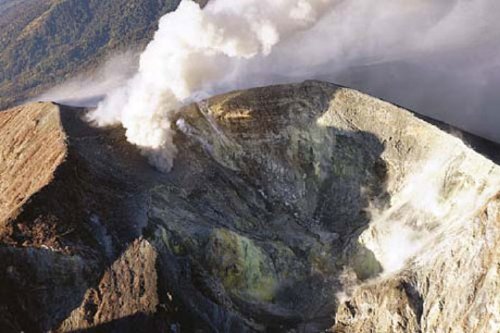
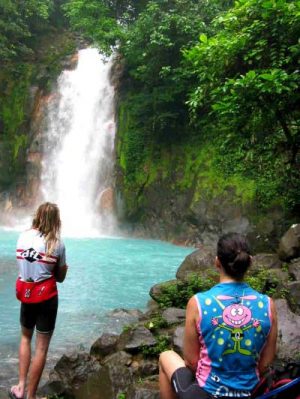
Turrialba Volcano
Located within the Central Volcanic range of Costa Rica, Turrialba Volcano is situated approximately 45 minutes from the beautiful town of Turrialba.
Facts about Turrialba Volcano
- Turrialba Volcano is located next to Irazu Volcano on the Central Volcanic range
- Turrialba Volcano has a similar lunar landscape to that of Irazu Volcano
- The summit of Turrialba Volcano reaches 10,919 ft (3,328 m)
- Turrialba Volcano is made up of three craters; the largest is 164 ft (50m) in diameter
- The main crater has a lake with fumarolic activity. The western crater has had magmatic activity in the past, but none registered within the past 150 years
- On clear days you can see the Pacific and Atlantic coast as well as the Poas and Irazu volcanoes from the summit of Turrialba Volcano
- The last significant eruption was in 1866 but Turrialba Volcano continues to be active with plenty of smoke and gas activity noticeable from its highest peak and the nearby fumaroles
- It was once possible to visit the main crater, but increased activity beginning in 2001 has reduced visiting time to this area to just fifteen minutes
- In January 2010, two adjacent villages were evacuated as Turrialba Volcano began to throw out ash
- It is possible to hike to the top of Turrialba Volcano and this can take from one to three hours depending on ability
- A dense primary and secondary cloud forest of ferns and mosses rest just below the summit of Turrialba Volcano
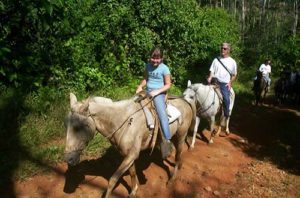
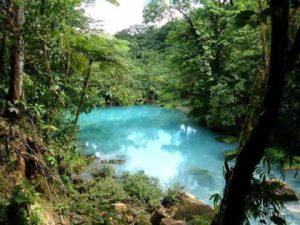
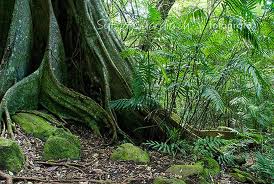
Turrialba Volcano Tours and Activities
- In comparison to other active volcanoes in Costa Rica, the Turrialba Volcano receives few visitors largely due to the summits inaccessibility
- Guided bird watching and wildlife tours are available from the town of Turrialba to the Turrialba Volcano National Park
- Turrialba Volcano National Park is home to over 84 different species of birds and 11 species of mammals
- A viewing platform and steps were built around the crater in 2007
- Turrialba Volcano has few facilities and no ranger station; make sure to pack plenty of supplies including drinking water, snacks and a sweater to keep you warm
Directions to Turrialba Volcano
To get to Turrialba Volcano National Park from San Jose, take the highway heading toward Cartago and Irazu Volcano.
Take the exit toward Pacayas, continue until you get to La Pastora. Get ready for the road to make a double left. Continue until you reach the Café Danza con Nubes, a trail leads from the café to the Turrialba Volcano National Park.
The town of Turrialba is located approximately 44 miles (71 km) east of San Jose. From there the national park is just a short drive away. It is recommended to have a 4WD vehicle if you plan on accessing the park on your own.

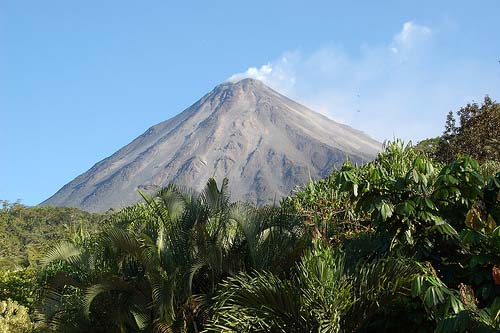
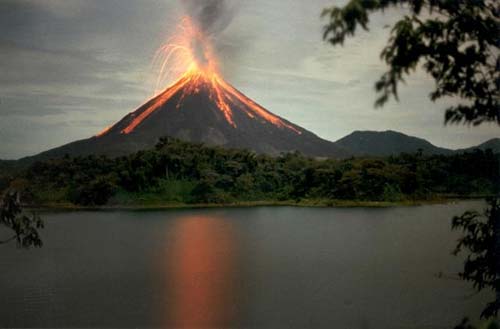
 +1 888-818-2097
+1 888-818-2097
 +506 8932-4731
+506 8932-4731